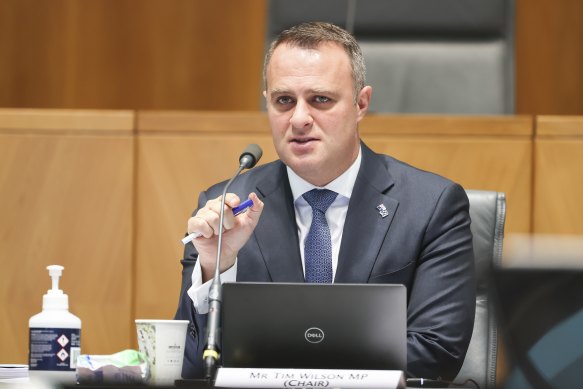This was published 3 years ago
‘Follow our lead’: federal government calls for world to follow its climate policy
By Mike Foley
The world has probably blown its chance of limiting global warming to 1.5 degrees, according to yet another damning climate change report from the United Nations, which urges a quick and drastic reduction in global greenhouse emissions.
The Intergovernmental Panel on Climate Change (IPCC) report showed that if the policies that were in place at the end of 2020 are maintained the world would probably hit a devastating 3.2 degrees of warming over pre-industrial levels.

Assistant Energy and Emissions Reduction Minister Tim Wilson says other countries should follow Australia’s work on emissions. Credit: Alex Ellinghausen
“It’s now or never, if we want to limit global warming to 1.5 degrees,” IPCC working group co-chair Jim Skea said.
The United Nations Secretary General Antonio Guterres criticised Australia as recently as last month as being among a handful of “holdouts” on short-term emission reduction targets. But federal Assistant Energy and Emissions Reduction Minister Tim Wilson said the report showed the world should follow Australia’s approach.
“What we actually need is other countries to follow our lead. While we’ve committed to net zero by 2050, we’ve got the UK now asking for wriggle room and backsliding on their commitment. China hasn’t even committed to net zero by 2050,” Mr Wilson told ABC Radio National on Tuesday morning.
The UK has set a target to cut emissions by 78 per cent by 2035, compared with 1990 levels. It had reduced emissions 40 per cent between 1990 and 2019.
China has committed to hit net zero emissions by 2060. China’s President Xi Jinping has said emissions would rise to 2030 and decline to net zero over the next three decades.
Mr Wilson was referencing a comment from UK Prime Minister Boris Johnson who said, following Vladimir Putin’s invasion of Ukraine, that western nations should get “a climate change pass” to wean themselves off Russian gas supply – while retaining their emissions targets.
Other countries should adopt Australia’s approach to “technological innovation and deployment”, Mr Wilson said.
“We need global emissions to come down which means we need other countries to follow our leadership in making sure they take decisions they back them in.”
The federal government is committed to its Paris Agreement target to reduce emissions by at least 26 per cent by 2030, based on 2005 levels of greenhouse pollution, and hit net zero by 2050. It has pledged billions in financial support to expand fossil fuel production under a “gas-fired recovery” to the COVID economic downturn.
The government views gas as a transition fuel in the electricity grid as it integrates more renewables. It is aiming for commercial gas as an energy source to produce “clean hydrogen”, which cuts emissions by using carbon capture and storage technology.
Mr Wilson pointed out that government projections forecast Australia’s emissions reduction will exceed its target to reach 35 per cent by 2030.
Australia’s emissions have fallen 20 per cent compared to the 2005 baseline, driven by a reduction in clearing of native vegetation by farmers – which counts towards climate action because of the carbon sequestered in the saved trees.
But Australia’s industrial emissions have continued to rise and if the changes to historical rates of land clearing were excluded, national emissions would have risen by about 7 per cent, according to analysis by Crawford School of Public Policy honorary associate professor Hugh Saddler.
The federal government’s “technology not taxes” approach to climate action is aimed at reducing the cost of low emissions technologies so that industry can transition to clean solutions without economic losses. Prime Minister Scott Morrison says Australia’s investments will contribute to global progress when they are adopted around the world.
The federal opposition has pledged to cut emissions 43 per cent by 2030, based on 2005 levels, and to hit net zero by 2050.
In a significant departure from the government’s policy Labor said it would, if elected, set limits on the 215 biggest industrial polluters that cumulatively generate 28 per cent of national emissions by ramping up controls under the so-called safeguard mechanism.
Both major parties support ongoing fossil fuel production in Australia as long as there is international demand for exports.
Greens leader Adam Bandt said that “Australia is a huge part of the problem” of fossil fuel exports, on which it ranks third in the world behind Saudi Arabia and Russia.
“If you don’t have a plan to get out of coal and gas, you don’t have a credible climate plan,” Mr Bandt said.
Australian National University Professor Frank Jotzo said the impacts of climate change would be far worse if global warming hit 2 degrees compared to 1.5 degrees. But due to the lack of emissions reduction to date it was no longer “realistically achievable” for the world to keep warming under 1.5 degrees, Professor Jotzo said.
Jacqueline Maley cuts through the noise of the federal election campaign with news, views and expert analysis. Sign up to our Australia Votes 2022 newsletter here.